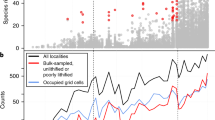Abstract
This essay discusses protist species number and geographic distribution, both heavily influenced by undersampling and human introductions. The features of the ubiquity model and the moderate endemicity model are compared. I recognize five main flaws of the ubiquity model, viz., the ignorance of the extraordinary possibilities protists have to speciate due to their short generation time and the likelihood that many persisted over geological time scales; that all protist species have high abundances; that their small size is a main reason for global distribution; the ignorance of human introductions; and the rejection of literature evidence on the occurrence of flagship species with restricted distribution in a wide variety of protists. Thus, the data available support the moderate endemicity model which proposes about 300,000 extant, free-living protist species, of which one third might have a restricted distribution, i.e., is not cosmopolitan in spite of suitable habitats. To sum up, the distribution of protists, flowering plants, and larger animals has much in common, but protists usually have wider ranges and thus a higher proportion of cosmopolites. Future research should reconcile morphologic, genetic, and ecological species concepts because this is crucial for determining the number of protist species. Further, greatly intensified research is required on morphospecies in heterotrophic protists because their diversity has never been investigated in large areas of the earth.



Similar content being viewed by others
References
Bonnet L (1983) Interet biogeographique et paleogeographique des thecamoebiens des sols. Annls Stn limnol Besse 54:777–784
Chao A, Li PC, Agatha S et al (2006) A statistical approach to estimate soil ciliate diversity and distribution based on data from five continents. Oikos 114:479–493
Corliss JO (2000) Biodiversity, classification, and numbers of species of protists. In: Raven PH, Williams T (eds) Nature and human society. The quest for a sustainable world. National Academy Press, Washington, pp 130–155
Dolan JR (2005) An introduction to the biogeography of aquatic microbes. Aquat Microb Ecol 41:39–48
Dragesco J, Dragesco-Kernéis A (1986) Ciliés libres de l’Afrique intertropicale. Faune Trop 26:1–559
Fenchel T (1993) There are more small than large species? Oikos 68:375–378
Fenchel T, Finlay BJ (2004) The ubiquity of small species: patterns of local and global diversity. BioScience 54:777–784
Finlay BJ, Corliss JO, Esteban G et al (1996) Biodiversity at the microbial level: the number of free-living ciliates in the biosphere. Q Rev Biol 71:221–237
Finlay BJ, Esteban GF, Fenchel T (2004) Protist diversity is different? Protist 155:15–22
Finlay BJ, Esteban GF, Brown S et al (2006) Multiple cosmopolitan ectotypes within a microbial eukaryote morphospecies. Protist 157:377–390
Foissner W (1999) Protist diversity: estimates of the near-imponderable. Protist 150:363–368
Foissner W (2004) Ubiquity and cosmopolitanism of protists questioned. SIL News 43:6–7
Foissner W (2006) Biogeography and dispersal of micro-organisms: a review emphasizing protists. Acta Protozool 45:111–136
Foissner W (2007) Dispersal and biogeography of protists: recent advances. Jpn J Protozool 40:1–16
Foissner W, Agatha S, Berger H (2002) Soil ciliates (Protozoa, Ciliophora) from Namibia (Southwest Africa), with emphasis on two contrasting environments, the Etosha Region and the Namib Desert. Denisia 5:1–1459
Hawksworth DL (2001) The magnitude of fungal diversity: the 1.5 million species estimate revisited. Mycol Res 105:1422–1432
Heimans J (1969) Ecological, phytogeographical and taxonomic problems with desmids. Vegetatio 17:50–82
Helbig AJ (2005) A ring of species. Heredity 95:113–114
Hey J, Waples RS, Arnold ML et al (2003) Understanding and confronting species uncertainty in biology and conservation. Trends Ecol Evol 18:597–603
Hong SH, Bunge J, Jeon SO et al (2006) Predicting microbial species richness. Proc Natl Acad Sci USA 103:117–122
Mann DG, Droop SJM (1996) Biodiversity, biogeography and conservation of diatoms. Hydrobiologia 336:19–32
Martens K (1997) Speciation in ancient lakes. TREE 12:177–182
Meyer E, Foissner W, Aescht E (1989) Vielfalt und Leistung der Tiere im Waldboden. Öst Forstz 3:15–18
Mitchell EAD, Meisterfeld R (2005) Taxonomic confusion blurs the debate on cosmopolitanism versus local endemism of free-living protists. Protist 156:263–267
Norris RD (2001) Pelagic species diversity and evolution. Paleobiol 26(Suppl):236–258
Schluter D (1998) Ecological causes of speciation. In: Howard DJ, Berlocher SH (eds) Endless forms. Univ Press, New York, pp 114–129
Smith HG, Wilkinson DM (2007) Not all free-living microorganisms have cosmopolitan distributions—the case of Nebela (Apodera) vas Certes (Protozoa: Amoebozoa: Arcellinida). J Biogeogr 34:1822–1831
Stoeck T, Kasper J, Bunge J et al (2007) Protistan diversity in the artic: a case of paleoclimate shaping modern biodiversity? PLoS ONE 8:1–16
Taylor JW, Turner E, Townsend JP et al (2006) Eukaryotic microbes, species recognition and the geographic limits of species: examples from the kingdom fungi. Phil Trans R Soc 361:1947–1963
Tyler PA (1996) Endemism in freshwater algae with special reference to the Australian region. Hydrobiologia 336:1–9
Webster J (1983) Pilze. Eine Einführung. Springer, Berlin
Wilkinson DM (2001) What is the upper size limit for cosmopolitan distribution in free-living microorganisms? J Biogeogr 28:285–291
Acknowledgements
Supported by the Austrian Science Foundation (FWF, project P19699-B17). The technical assistance of Mag. Gudrun Fuss is greatly acknowledged.
Author information
Authors and Affiliations
Corresponding author
Additional information
Special Issue: Protist diversity and geographic distribution. Guest editor: W. Foissner.
Rights and permissions
About this article
Cite this article
Foissner, W. Protist diversity and distribution: some basic considerations. Biodivers Conserv 17, 235–242 (2008). https://doi.org/10.1007/s10531-007-9248-5
Received:
Accepted:
Published:
Issue Date:
DOI: https://doi.org/10.1007/s10531-007-9248-5




